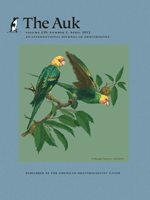BioOne.org will be down briefly for maintenance on 14 May 2025 between 18:00-22:00 Pacific Time US. We apologize for any inconvenience.
Articles (3)
RESEARCH ARTICLES (13)
LETTERS (2)
MEMORIALS (2)
BOOK REVIEWS (4)
POSTSCRIPT (1)

No abstract available
No abstract available
No abstract available
Representativeness of Land Cover Composition along Routes of the North American Breeding Bird Survey
No abstract available
No abstract available
No abstract available
No abstract available
No abstract available
No abstract available
No abstract available
No abstract available
No abstract available
